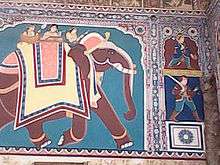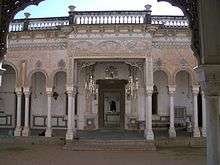Fatehpur, Rajasthan
| Fatehpur फतेहपुर Fatehpur Shekhawati | |
|---|---|
| city | |
| Nickname(s): Fatehpuri | |
 Fatehpur  Fatehpur Location in Rajasthan, India | |
| Coordinates: 27°59′N 74°57′E / 27.98°N 74.95°ECoordinates: 27°59′N 74°57′E / 27.98°N 74.95°E | |
| Country |
|
| State | Rajasthan |
| District | Sikar |
| Government | |
| • Member of Legislative Assembly | Nand kishore Mahriya |
| Elevation | 324 m (1,063 ft) |
| Population (2001) | |
| • Total | 78,471 |
| Languages | |
| • Official | Hindi |
| Time zone | IST (UTC+5:30) |
| PIN | 332301 |
| Telephone code | 91-1571 |
| Vehicle registration | RJ-23 |
| Avg. summer temperature | 48-49 °C |
| Avg. winter temperature | 0-1 °C |
Fatehpur is a town in the Sikar district of Indian state Rajasthan. It is part of the Shekhawati region. It is midway between Jaipur and Bikaner on National Highway 11. Fatehpur is famous for grand havelis with frescos, which are significant architectural structures of the Shekhawati region. A number f monumental wells and springs known as bawdis are also centres of attraction.
History
Fateh Khan Kayamkhani (who claim Chauhan descent) established the city of Fatehpur in 1451 AD. He constructed the fort of Fatehpur in 1449 and ruled up to 1474.[1] The city served as the capital of Shekhawati Riyasat under its ruler and founder Fateh Khan, the Muslim Nawab. Fateh Khan's eldest son was Jalalkhan, who founded the village Jalalsar 10 km south of Fatehpur. After the death of Fateh Khan in 1474, Jalalkhan became the Nawab of Fatehpur. Jalakhan was a warrior and kind Nawab. He left the Fatehpur bid (forest land) for the purpose of grazing of animals.[2]
Geography
Fatehpur is located at 27°59′N 74°57′E / 27.98°N 74.95°E.[3] It has an average elevation of 324 metres (1066 ft).
Qureshi Farm
The livestock farm was constructed in October 2011 and was officially inaugurated by the local MLA BharuKhan and Senior Yaqub Haji on 30 April 2012. The project 'Empower rural India through Goat farming via social media'[4] landed the owner Akbar Khan Qureshi as the Top 3 humanitarian projects[5] worldwide by Nations United.[6] The farm conducts research on breed development and maintains pedigree of Indian goats and camels.
Nadine Le Prince Cultural Centre
A haveli was purchased in 1998 by French artist Nadine Le Prince, a descendant of prestigious French painter Jean-Baptiste Le Prince. The "Nand Lal Devra Haveli" (meaning "The Haveli of Nandlal Devra": Nandlal Devra is the name of the merchant who constructed the haveli) was originally built in 1802 by a rich family of traders, the Devras, who were officers at the court of the local Maharaja. Since then, Nadine Le Prince has entirely restored the palace and all the frescoes. She is doing much to preserve and restore the heritage of havelis throughout Shekhawati, working with other associations to give the havelis a second life.
Besides, she has opened a cultural center where her most precious paintings are exhibited along with many French and Indian modern artists' works to mingle old and contemporary art. The Kala Dirga Gallery of Contemporary Art features pieces made by artists about India; the Saraswati Gallery covers traditional themes of Rajasthan, through painting. In addition, there are two little Tribal Art Galleries exhibiting the artistic work of tribes, as Patachitras and Madhubani. The aim of the project is to offer the visitor a large panorama of works and visions of India; the exhibited artists and art are from France, from Jaipur Fine Art School and local Shekhawati painters.[7]
Le Prince has established a program of artists in residence and plans to organize other cultural events, such as dance and music shows, to make this enchanting palace become a lively place for art in all forms.
The Dwarkadheesh Temple
The Dwarkadheesh Temple popularly known as 'Asharam Temple' was built in the 19th century by the sons of Seth Asharam Ji Poddar in memory of their father. The murals of this temple are representative of the famous Shekhawati wall paintings also known as 'Open Air Art Gallery'.
The Jagannath Singhania Haveli
The Jagannath Singhania Haveli was constructed from 1857 to 1860. It's 50 feet tall and has some fine paintings of Radha and Krishna and shows some British men holding guns.
- It has a special nine-door room on the terrace which is open from all sides. There is air circulation from all sides and thus it remains cool naturally.
- Baithak: It has five doors which are exclusive to this haveli. Other baithaks in the region have three doors.
- Bara dari: A baradari, in Persian and Moghul architecture, is a building or room with 12 doors designed to allow the free draught of air. Persons of repute used it as a venue for formal and informal settings in hot weather. It is also known as the ‘mehfil’ room. The men would occupy the base area. There is an exclusive provision made for the women to sit upstairs in privacy.
- Rangeen Kamra: It is known as the colourful room. The specialty of this room is that it acts as a secret chamber and is renowned for its artistic beauty. The floors, walls as well as the ceilings are hand-painted depicting stories based on the life of Lord Krishna.
- Bhuran: It is also known as the underground safety room. It acts like a safe deposit valve which is closed from all sides.
The haveli has Naal on one side and Nohra on the other, which can be used as open space for parking, swimming pool and is large enough to construct the two together.
Saraf Haveli

This haveli was built around 200 years ago. It is famous among tourists visiting Fatehpur Shekhawati. The walls are beautifully decorated with original mural oil paintings. Its wooden doors are aesthetically crafted.
Fatehchandka ki Haveli

This haveli was built around 75 years ago by affluent Fatehchandka family. It has 3 chowks (open space) which is unique among other haveli's in region. It is constructed in such a way that entire haveli can be viewed from two ends. The doors are beautifully crafted with hand paintings on the walls. It is major attraction for tourists in the region.
Sitaram Kedia Ki Haveli
This haveli was constructed by Seth Shree Bohitram Kedia, grandfather of the late Sitaram Kedia. Rajendra Kumar Kedia is an eminent author and book lover. He and his son Anurag Kedia are the current owners.
The haveli has two chawnks or courtyards a garden with fountain at back and Naals on both sides; the wall paintings are traditional. It has a library and modern baths. It was first haveli in Fatehpur to have electricity (via generators) and called Bijliwali Haveli. In 1931 AD Sitaram Kedia was married to the daughter of Bajaj family of Bisau. On this occasion Rao Raja Maharaj Shri Kalyan Singh Ji Bahadur of Sikar Thikana came to bless the couple. Seth Shree Bohitram Kedia brought an aeroplane (popularly called 'Cheel Gadi' or eagle craft) to scatter invitations printed on handkerchiefs for all and flower petals on His Royal Highness. Pleased with the courtesy and respect His Royal Highness granted the family of Seth Shree Bohitram Kedia permission was given to wear gold ornaments below their waist (a privilege that only royals enjoyed in that era).
Although most rooms are locked one can visit the haveli free of any charge, courtesy the Kedia family: Sitaram Kedia Ki Haveli, opposite Poddar Girls School, near Roadways bus stand, Fatehpur Shekhawati, Rajasthan.
Jainism in Fatehpur
The Kashthasangh sect of Jainism continued to be practiced in Fatehpur among the Agrwals during the Kayam Khani rule, as attested by inscriptions of Samvat 1685, 1739, and then during the Shekhawat rule in sam. 1861.[8]
External links
References
- ↑ Goswami Rasa, page 11
- ↑ Sahi Ram: Ek adhurī krānti, page 5
- ↑ Falling Rain Genomics, Inc - Fatehpur
- ↑ http://www.qureshifarm.com/qureshi_farm.htm
- ↑ http://www.facesoftransformation.com/
- ↑ http://www.nationsunited.org/projects/
- ↑ Nadine Le Prince Cultural Centre
- ↑ Bhattarak Sampraday, Vidyadhar Johrapurkar, Jivaraj jain Granthmala, 1958, p. 234-235
